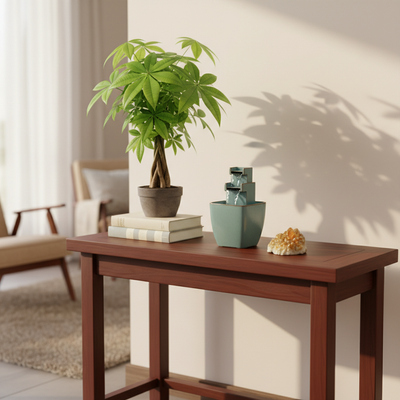As a parent, you want the best for your child. You set up daily routines to help them feel secure, give them healthy food to keep them strong, and show them love to help them feel good about themselves. But did you know that their bedroom could be set up in a way that helps them grow and feel even better? Many parents notice their child has trouble sleeping, can't sit still, or has a hard time focusing. Often, the problem might be how their room is arranged.
This is where kids bedroom feng shui can help. It's not complicated or mysterious. It's a simple, old way of arranging a room so that good energy can flow through it. What's the goal of feng shui in a child's bedroom? We want to help positive energy, called Qi, flow in a way that helps them sleep better, play happily, learn more easily, and feel emotionally balanced. This guide will teach you the basic ideas and give you clear steps to turn your child's room into a peaceful place that helps them grow.
Learning the Basics

To use feng shui well, it helps to understand why these ideas work. These main principles, explained in simple words, are the foundation for creating a balanced and helpful space for your child. Understanding them will help you make smart changes, not just follow a list of rules.
The Idea of Qi
Qi is invisible life energy that flows through all living things and spaces. This idea is very important in Chinese philosophy. In a child's room, we want this energy to be fresh, lively, and moving gently. When Qi gets stuck, often because of messy rooms or bad furniture placement, it can make people feel tired and trapped. But when Qi moves too fast or wildly, it can make people feel restless and worried. Our goal is to help this energy flow smoothly and in a helpful way.
Balancing Yin and Yang
Yin and Yang are two opposite but connected forces in the world. Yin is quiet, dark, soft, and calm energy that helps with rest and healing. Yang is bright, active, loud, and lively energy that helps with playing, learning, and being social. A child's bedroom needs both, but in the right balance. Most of the room should be Yin to help them stay calm and sleep well. But there should also be some Yang areas, like a bright desk or a colorful play corner, to encourage activity and creativity when they're awake.
The Five Elements
The Five Elements—Wood, Fire, Earth, Metal, and Water—are another important part of feng shui. Each element connects to certain colors, shapes, materials, and qualities. Together, they help create harmony and balance. Wood represents growth and life. Fire means passion and energy. Earth gives stability and care. Metal brings clarity and focus. Water relates to flow and feelings. We'll explore how to use these elements when decorating to make your child's space even better.
The Command Position
If you only make one change in your child's room, make it this one. The command position is the most important rule in feng shui for helping your child feel safe, confident, and in control. It applies to placing the two most important pieces of furniture in the room: the bed, where they rest and recharge, and the desk, where they learn and create. Being in "command" means being able to see who or what is coming into your space. This removes hidden worry and lets the mind fully relax or focus.
Placing Your Child's Bed
A child's ability to sleep well is directly connected to how safe they feel. The command position for the bed makes sure they feel protected and in control of their space, leading to deeper, better sleep.
- The Main Rule: The bed should be placed so the child can see the bedroom door while lying down, but not be directly in line with it. Imagine a diagonal line from the door to the farthest opposite corner; this is often the best spot for the bed. Being in the direct path of the door can feel jarring as energy rushes in and out.
- Strong Headboard Support: The bed must have a solid headboard and be placed firmly against a solid wall. A headboard represents support and stability in life. The wall acts like a "mountain" behind them, giving a hidden feeling of protection from behind.
- What to Avoid:
- Placing the bed directly under a window is a main "don't." Qi can escape through the window, and the sleeper is more open to drafts and outside energy, leading to restless sleep.
- Avoid placing the bed under a sloped ceiling, an exposed beam, or a ceiling fan. These features can create a sense of heavy energy or "cutting" Qi that weighs down on the child during sleep.
- Make sure the foot of the bed does not point directly out the door. This is known as the "coffin position" and is considered the worst placement as it symbolizes energy being carried away.
Setting Up the Study Desk
The same rules of command apply to the desk to improve focus, creativity, and school success. A child who feels secure and aware of their surroundings can concentrate better on their work.
- The desk should be positioned so the child can see the door while sitting. This prevents them from being surprised or feeling worried about someone coming up from behind, allowing their brain to focus fully on their work.
- Facing a blank wall is one of the worst positions for a desk. It can symbolically block opportunities and limit creativity. If this layout can't be avoided because of space limits, there are fixes. Place a small mirror on the desk to reflect the door, or hang an inspiring piece of art or a bulletin board with positive images on the wall to create a sense of depth and vision.
- Just like the bed, having a solid wall behind the desk chair provides important support, giving the child a feeling of being backed and secure in their efforts.
The Bagua Map for Kids
The Bagua is a feng shui energy map, a guide that you can place over the floor plan of your child's room to see how different areas connect to specific parts of their life. This goes beyond general advice and gives you a powerful tool to improve areas you want to support, whether it's creativity, family harmony, or school success.
To use the map, stand at the doorway of your child's bedroom, looking into the room. Mentally divide the space into a 3x3 grid, like a tic-tac-toe board. The row of three squares closest to you is the "front" area, the three in the middle are the "middle" area, and the three farthest from you are the "back" area. Each of these nine sections, or "guas," has a unique meaning designed for a child's world.
| Bagua Area (from door) | Child-Focused Meaning | How to Make It Better |
|---|---|---|
| Back Left: Wealth & Prosperity | Sense of abundance, self-worth | A healthy plant, a special piggy bank, purple/green/gold accents. |
| Back Middle: Fame & Reputation | How they are seen, their inner light | Display their awards/artwork, good lighting, red accents. |
| Back Right: Love & Relationships | Friendships, self-love | Photos with friends/family, items in pairs, pink/white accents. |
| Middle Left: Family & Health | Family bonds, physical growth | Family photos, sturdy wooden items, green/blue accents. |
| Middle Right: Creativity & Children | Imagination, hobbies, fun | A space for art supplies, display their creations, white/pastel colors. |
| Center: Health & Well-being (Tai Chi) | Overall balance, grounding | Keep this area open and clutter-free, earthy tones, a soft rug. |
| Front Left: Knowledge & Self-Cultivation | Learning, schoolwork, wisdom | A bookshelf with favorite books, a quiet reading nook, blue/black accents. |
| Front Middle: Career & Path in Life | Future dreams, life journey | Inspiring posters, items related to their dreams (e.g., a toy spaceship). |

| Front Right: Helpful People & Travel | Mentors, friends, support | A globe, maps, drawings of people who help them (teachers, grandparents). |
A Real Example
Theories are helpful, but seeing these ideas work in real life provides true understanding. At THE QI FLOW, we often work with families facing common problems, and the results of applying these simple changes can be amazing.
The Problem
We were asked to help by the parents of Leo, a smart 7-year-old who had ongoing trouble falling asleep and staying asleep. He was often restless during the day and had trouble focusing on his homework. A look at his room showed a classic messy setup: his bed was pushed directly under a large window, his desk faced a blank wall, and toys and books were piled in every corner, creating significant visual and energetic mess.
The Fix
Our team at THE QI FLOW recommended a few key, high-impact changes based on the basic principles of kids bedroom feng shui.
1. First, we addressed the most important issue: his bed. We moved it to the command position, placing it against the solid wall opposite his door, with a clear view of the entrance. This immediately created a hidden sense of security.
2. Next, we moved his desk. We turned it 90 degrees so it was against a side wall, allowing him to sit with a supportive wall behind him while still being able to see the door.
3. We then tackled the mess. We worked with Leo and his parents to set up a system of covered storage bins and a "one-in, one-out" rule for new toys to keep things manageable.
4. Finally, using the Bagua map, we placed his bookshelf in the front-left Knowledge area and hung a happy family photo in the middle-left Family area to strengthen those energies.
The Outcome
The parents reported a big change within a week. "The change was almost immediate," his mother told us. "Leo started sleeping through the night, and he actually enjoys sitting at his desk now. The whole energy of the room feels calmer. We are so grateful for the practical guidance from the THE QI FLOW team." This case study shows how smart placement and organization can directly impact a child's well-being.
Color, Decorations, and Mess
Once the furniture is correctly placed, you can fine-tune the room's energy using color, decorations, and, most importantly, good organization. These elements work together to create the right balance of calming Yin energy for rest and lively Yang energy for play.
Choosing Helpful Colors
Color has a powerful mental and energetic effect. For a child's bedroom, the goal is to create a calming background with intentional pops of energy.
* The best choices for overall wall colors are soft, muted, and earthy tones that promote a sense of peace and calm (Yin). Think of soft blues, gentle greens, sandy beiges, or warm grays.
* Use brighter, more active (Yang) colors as accents. These are perfect for a play area, a feature wall behind a desk, or in decorative items like pillows and artwork to stimulate creativity and joy.
* Good color choices include:
* Blue and Green: Connected to the Wood element, these colors support growth, healing, and calm.
* Pastels: Soft pinks, lavenders, and yellows are gentle and soothing, ideal for a younger child's room.
* Earthy Tones: Beiges, tans, and soft terracotta are connected to the Earth element, promoting grounding and stability.
* Use carefully: Bright red and deep orange are associated with the Fire element. While great for energy, they can be too stimulating in large amounts and may interfere with sleep. Use them sparingly as small accents.
The Number One Energy Blocker
You can have the most perfectly arranged furniture and beautiful colors, but if the room is filled with mess, the Qi will get stuck. Mess is the number one energy blocker in any space. For a child, it can create feelings of being overwhelmed, confused, and unable to focus or rest.
- Use smart storage solutions. Covered bins and baskets are far better than open shelves, as they contain the chaotic energy of many small items. Under-bed drawers can be used, but with an important warning.
- Create a specific home for everything. Teach your child that toys, books, and clothes have a place they return to at the end of the day. This creates a sense of order and responsibility.
- Regularly clean out. Every few months, go through toys and clothes with your child to donate items that are broken or have been outgrown. This creates space for new energy and teaches a valuable life lesson.
- Importantly, avoid storing items under the bed. This space should remain open to allow Qi to move freely around your child while they sleep. Storing things here, especially messy items like old toys or schoolwork, can create blockages that disrupt sleep. If you must use this space, store only soft, sleep-related items like spare blankets and sheets.
Feng Shui "Don'ts"
Sometimes, the quickest way to improve a room's energy is to remove the negative influences. Here is a simple checklist of things to avoid in a child's bedroom for immediate improvement.
- Avoid Mirrors Facing the Bed. A mirror reflecting the bed can disturb sleep by bouncing too much active energy around the room. It is also believed to startle the soul when it returns to the body during the night. If a mirror is on a closet door facing the bed, cover it with a cloth or curtain at night.
- Limit Electronics. TVs, tablets, and game consoles give off strong, disruptive Yang energy and electromagnetic fields (EMFs) that work against the restful Yin energy needed for sleep. Ideally, remove all electronics from the bedroom. If that's not possible, make sure they are completely powered off and covered at night.
- No Aggressive Images. Be mindful of the art and posters in the room. Images of fighting characters, weapons, or aggressive scenes can bring unsettling and anxious energy. Choose peaceful landscapes, inspiring figures, or your child's own happy artwork.
- Remove Overhead Mess. Avoid installing heavy shelves, large mobiles, or bulky light fixtures directly over the head of the bed. These create "sha qi" or heavy energy, which can cause a hidden feeling of being threatened or weighed down during sleep.
- No Water Features. While lovely in other parts of the home, aquariums, fountains, or even images of large bodies of water are not recommended for bedrooms. The energy of water is active and can bring the symbolic energy of worry or emotional overwhelm into a space designed for rest.
- Keep the Space Under the Bed Clear. As mentioned, this is an important rule. The energy beneath you needs to flow freely to support your health and well-being while you sleep. Keep this area empty.
Your Child's Safe Space
Creating a harmonious bedroom for your child is a meaningful act of love. By using these principles of kids bedroom feng shui, you are doing more than just decorating a room; you are thoughtfully shaping an environment that nurtures their mind, body, and spirit.
Remember the most impactful steps: place the bed in the command position for security, clear the mess to allow positive energy to flow, and use color and decorations intentionally to create a balance between rest and play. View this not as a strict set of rules, but as an intuitive guide to building a safe space where your child can feel safe, supported, and ready to grow into their best self.








0 comments